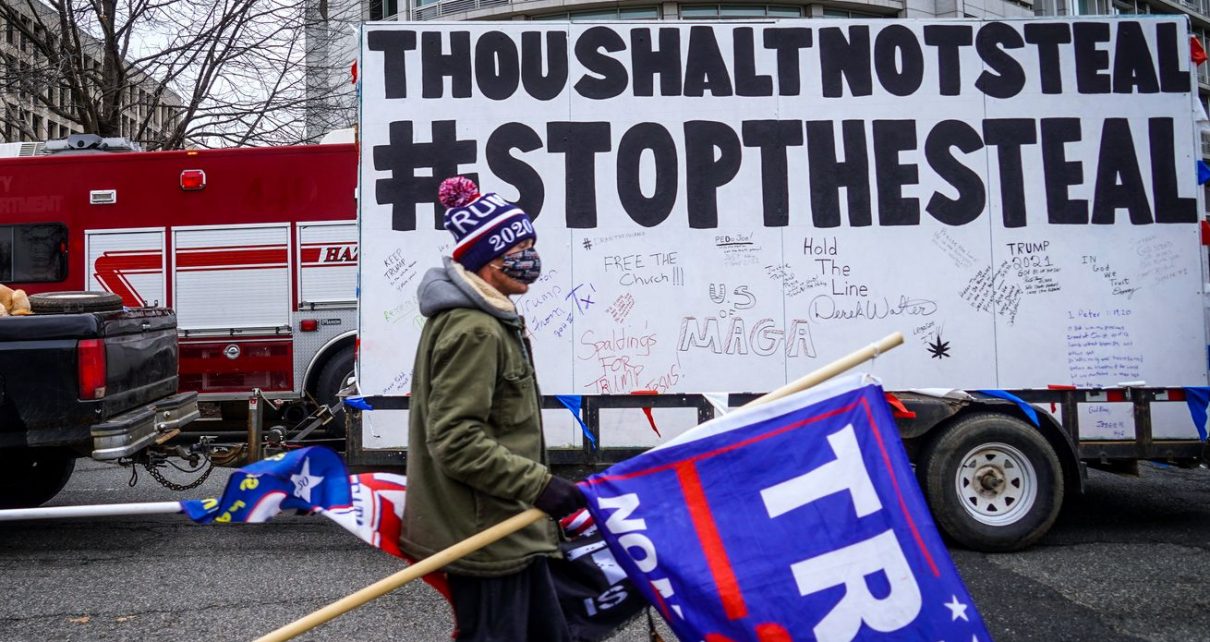
What America needs to do to avoid the next election crisis, according to a new report.
The 2020 election somehow managed to be both a success and a stunning failure.
The pandemic, the threat of foreign interference, misinformation, changes at the US Postal Service, fears of voter intimidation and violence — any or all of it could have upended the vote.
The worst did not happen. Election administrators adjusted rules to protect health and guarantee people had options for how to cast their vote. Voting infrastructure was secured, and foreign adversaries failed to substantively disrupt the voting. Voter turnout hit historic highs, a record number voted early and by mail, and about 160 Americans participated in the democratic process.
The crisis, instead, came after the polls closed.
President Donald Trump refused to concede, fomenting conspiracy theories about widespread voter fraud, mounting dozens of frivolous lawsuits, and delaying the presidential transition. He tried to pressure officials, most notably Georgia’s secretary of state, to change the vote in his favor.
Trump’s Republican allies backed him up, and some opinion polling showed more than half of Republicans believed Trump was the rightful winner of the election. On January 6, a mob breached the US Capitol, interrupting — if only temporarily — the certification of the electoral votes for Joe Biden’s win.
Now, thousands of armed National Guard troops are deployed to the Capitol, turning the seat of government into a fortress on the eve of President-elect Joe Biden’s inauguration.
This almost unfathomable split screen of the 2020 election raises an obvious challenge: how to prevent this from happening again.
The National Task Force on Election Crises, a bipartisan group of experts, lawyers, and voting advocates, tried to grapple with this question in the aftermath of the 2020 election. On Friday, they released a final report on what went right; what went very, very wrong; and what reforms need to be undertaken to try to make democratic institutions more resilient going forward.
Those reforms include the expansion of voting options like vote-by-mail and early voting, better control of disinformation on social media, and changes to laws like the Electoral Count Act and Presidential Transition Act.
The report’s authors note that America’s democratic institutions held largely because enough people — election officials, secretaries of state, especially — did their constitutional duties and withstood pressure from Trump and his allies. The courts, too, dispatched with meritless lawsuits.
Even though the attempts to overturn the election were ultimately unsuccessful, the report notes, they “likely caused lasting damage, not only to the acceptance of the 2020 election outcome, but to the perceived legitimacy and long-term stability of American institutions and our system of government.”
And the institutions may not hold next time.
“We need to structure all of the relevant institutions so that they are positioned to hold in any crisis,” Adav Noti, a member of the task force and senior director of trial litigation and chief of staff at Campaign Legal Center, told me.
Even with this goal of preparing for and preventing the next crisis, the task force report acknowledges that the worst can — and might — happen again.
Some things worked in 2020. A lot didn’t. Here’s what needs to be strengthened.
The report focuses on three big areas where reforms are needed: election administration, election laws, and the news ecosystem — specifically how social media companies and media companies respond to disinformation.
It also offers some general recommendations, including a congressional commission on nonpartisan election reform.
Election administration
The coronavirus pandemic forced states and voters to rethink how they voted. The task force recommends those methods — mail-in voting, early voting, drop boxes, even curbside voting — should be made more permanent.
“The more options that voters have to vote safely and securely,” the report says, “the more likely that crises, ranging from a future pandemic to cyberattacks to ones we cannot envision, will not overwhelm our election systems or limit the ability of Americans to exercise their right to vote.”
Another crisis could happen, and rather than scrambling to change rules and laws, both election officials and voters will be prepared and know their options. And it strengthens US democracy by potentially increasing voter access and participation, bringing more people into the democratic process.
Another big reform the report’s authors suggest is expanding the pre-processing of ballots.
In the 2020 elections, different states had different rules on when they could start to open mail-in ballots and when they could begin to tally them. States like Pennsylvania and Wisconsin could not begin to process ballots until Election Day, which delayed the final tally. Other states like Florida processed ballots as they come in.
That made for uneven reporting of results, and a delay in the overall announcement of the winner of the presidential election. And that created a window for misinformation to go into overdrive.
A lot of this stuff, as the task force notes, requires money. The authors say Congress needs to allot more money to states and localities to manage and secure elections. Additional funding will also ease perennial problems of US democracy, like long lines or voting machine malfunctions. Voting is critical infrastructure, and it should be treated as such.
Electoral laws
When Trump refused to concede the election — and really, before then, when he basically said he wouldn’t concede if he lost — journalists, civil society groups, and experts were trying to game out what, if anything, he could actually do try to stay in power.
Would he try to get the Supreme Court to decide the election? Could he successfully pressure states not to certify the votes (something he tried)? Or pressure state legislators to appoint alternate electors? Could he get Congress to object to the electoral count? Could he get Vice President Mike Pence to do, well, anything?
The usual ho-hum work of certifying votes and Congress’s certification of the count went under the microscope. And suddenly everyone wanted to know what the Electoral Count Act of 1887 had to say. The problem is that the law is outdated and very ambiguous.
As Noti put it, if there’s a major election dispute in the future — say, Congress doesn’t certify the election results — there should be clear answers on how to resolve these issues.
The task force is realistic that this isn’t a simple task, and suggests this may take a complete revamping of the century-old legislation, and potentially even constitutional amendments.
For example, the task force recommends making clear what counts as a legitimate objection — i.e., not just “I don’t like the results” — and potentially distinguishing a clearer role for the courts in any election disputes.
It also recommends reforming legislation regarding the aftermath of the election, specifically the Presidential Transition Act, which governs the transfer of power from one administration to the next.
This law has been updated many times over the years, but in 2020, Trump’s refusal to concede delayed the General Service Administration from “ascertaining” the rightful winner and beginning the process.
Here, the task force recommends that Congress potentially clarify a trigger for a transition to begin, rather than leaving it to the discretion of officials.
Social Media
In so many ways, 2020 was an outlier because Trump was the incumbent president. He complained of election fraud before anyone had even voted, and he fomented that lie afterward in his defeat.
That created a crisis in American democracy, and an apparent disconnect on whether the 2020 election was free and fair.
Experts on the task force acknowledged this is a major challenge, especially when the source of disinformation comes from the president himself. The deep polarization of the country and the divided media ecosystems aren’t exclusively election problems, but they contributed to the crisis this year.
Overall, the task force credits social media companies with being more aggressive this time around, learning the lessons of 2016, especially regarding foreign disinformation.
But it also questioned the efficacy of some of those changes. For example, Twitter labeled certain posts as containing misleading or disputed information, including plenty belonging to the president.
However, the authors of the report saw limitations on the effectiveness of this approach. For one, it wasn’t always done very quickly, giving time for conspiracy theories to spread across social media. And it still left conspiracy theories out in the public domain.
The task force recommends deleting those posts as a more effective tactic than labeling. It also suggests removing engagement metrics from posts, the idea being that if a lot of people liked or shared it, an unsuspecting person might be more likely to believe it legitimate. And it suggests removing things like trending lists, where algorithms can sometimes elevate conspiracy theories.
The task force, in general, recommends transparency — from social media companies as well as traditional media companies, including on how media outlets call elections.
The big picture: Prepare for 2022 or 2024, and every election after
The task force report offers some big-picture recommendations, knowing that this is just the start, not the end, of the soul-searching about this election.
A lot of the recommendations are fairly straightforward, but they’re also not going to be easy, given how polarized the country was, and still is, around the very act of voting.
And, as the authors point out, the fact of chaos was not exactly surprising, from pandemic interruptions to a president who has always said he would never concede. Some of those challenges were better managed than others.
The institutions were strained and battered, but they did prevail. But the 2020 election should help us understand that’s not a guarantee.
“[T]he opportunity and outcome of this reprieve must not be taken for granted. This election was also a warning,” the authors write. “There is no guarantee the institutional structures that held this time will not crumple if exposed to the same stress again.”




